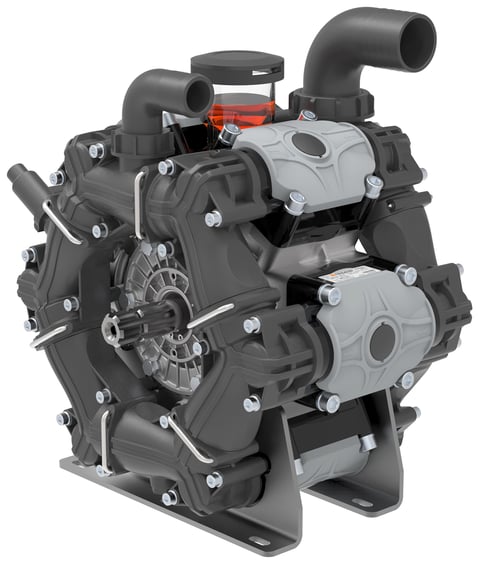Diaphragm pumps are the core of any spray boom or sprayer system. Their correct maintenance ensures, therefore, the correct operation of these machines and optimizes their performance.
Routine maintenance should be carried out at the end of each season or after 300 hours of operation. Even before that schedule, however, it is good practice to carry out preparatory steps for a correct operation - before, during and after each use - in order to avoid breakdowns or low performance.
GOOD PRACTICES FOR A CORRECT USE OF THE PUMP
First of all, before starting, inspect your pump and make sure that the hydraulic system shows no signs of wear or clogging. Also check that connections are tight and the pump is properly secured to its chassis.
One element to keep under constant control is the oil level, since perfect lubrication helps the operation of the individual components of the pump and increases its overall performance.
For this reason, Comet has created the NEW COMET ADDITIVATED MINERAL OIL C1 - available in 1 liter and 5 liter versions - which optimally preserves the components ensuring maximum performance and great reliability in all working conditions.
If the oil color (light yellow and clear when new) turns dark after a short time, it means that pistons or other components are rubbing in the cylinders.
If it turns gray or milky, one or more diaphragms are torn or perforated. In both cases, you should contact a service center for a more thorough maintenance. The same is true if drops in level are not fixed by topping up.
After each use, it is good practice to run clean water inside the pump to flush it of any residue of chemical products, taking care to rinse the suction filter.
In case of particularly cold weather, a special operation should be carried out before storing the pump for the winter season, i.e. making a mixture of water and anti-freeze liquid run inside the pump and emptying the manifolds.

ROUTINE PUMP MAINTENANCE
As we have already mentioned, routine maintenance should be carried out, depending on the event that occurs first, after 300 hours or at the end of the working season. There are 3 main phases:
- drain and flush the pump with clean water before disassembling and servicing it
- fit a new set of diaphragms
- inspect valves and change oil.
To carry out a correct maintenance, it is essential to rely on genuine spare parts: Comet has created a complete maintenance kit, including:
- Diaphragms
They are the most important element of the pump, available in NBR, Desmopan and Viton. - Valves
Suction and delivery valves. - Gaskets
O-ring to ensure watertight seal between the valve and the head.
In addition to spare parts, it is important to use appropriate tools such as a screwdriver, T-hex wrench, wrench and torque wrench, a brush to grease some components and some containers to collect oil, as well as personal safety equipment.
Let's see, now, what are all the steps to properly maintain your diaphragm pump:
- Remove oil from inside the pump
- Remove the pump head
- Remove the diaphragm
- Position the axial sleeve hole perpendicular to the shaft, then position the piston at the highest point.
- Grease the internal hole of the diaphragm and place it in its seat.
- Rotate the pump shaft until the diaphragm is on the piston, then screw tight
- Grease the new gaskets and replace the previous ones on the head
- Rotate the shaft to bring the piston downwards, then mark it
- After greasing the outside of the diaphragm, reposition the head by tightening the 4 cross-head screws using a torque wrench.
- Remove the valve cap, valve and gaskets; replace all and reinstall the valve cap.
- Fill with oil by tilting the pump to one side to let the air escape, then rotate the shaft as far as the lower point of the piston; tilt the pump and wait about 1 minute for the air to escape.
- Repeat the process on all other pistons and top the oil up to the correct level

To help you with these operations, here are some video-tutorials for the main Comet pumps, with step by step details of each job to be made.
Comet IDS 1701 HD - High Pressure Diaphragm Pumps
Comet APS 145 - High Pressure Diaphragm Pumps
Comet BPS 300 - Low Pressure Diaphragm Pumps
Comet APS 41 - High Pressure Diaphragm Pumps
TROUBLESHOOTING
In addition to routine maintenance, it can happen that a pump suffers from failures or is subject to sudden breakdowns.
Knowing how to recognize early warning signs, such as uneven pressure, deformation of certain parts, excessive pulsation or sudden drops in the oil level, can prevent greater damage.
Similarly, operating promptly in case of odd malfunctions allows extending the life of the pump.
Comet provides you with a very useful guide on routine maintenance and for all those operations that you can carry out on your own to keep your agricultural diaphragm pump at its best.

.jpg)








